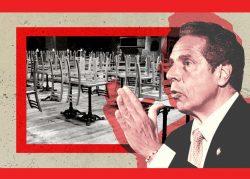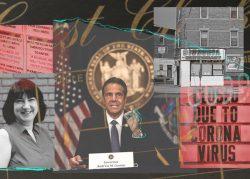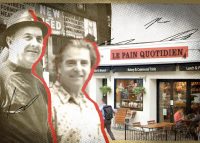When Mayor Bill de Blasio announced the Open Restaurants initiative in June, allowing customers to be seated in temporary curbside encampments, restaurateurs across the city rejoiced.
Having suffered through months of closures since March, restaurant owners were struggling to hang on, so they flooded the streets with tables, chairs, umbrellas and signage — and, in some cases, even more creative “streeteries.”
Even after indoor dining was reintroduced in September, it could only operate at 25 percent capacity, meaning outdoor dining continued to be the driving force for bringing in customers. Tables were suddenly surrounded by heaters, which then were enclosed by tents, which later became full-blown structures.
The restaurant at the Mark Hotel on the Upper East Side is one of those establishments. Its outdoor dining set-up at Madison Avenue and 77th Streets spans both sides of the building, with large plastic tents emblazoned with the hotel’s logo. But while this may have helped the hotel itself, the curbside eatery has “significantly interfere[d]” with one of its tenants’ ability to operate — and now, that tenant wants out of its lease.
Read more



Zadig et Voltaire, a clothing store located on the Madison Avenue side of the building, filed a lawsuit in New York State Supreme Court against The Mark, seeking to both terminate its lease and receive compensation for the “direct financial harm it has suffered” as a result of the hotel’s actions.
Neither Zadig et Voltaire nor The Mark responded to requests for comment. A lawyer for Zadig et Voltaire declined to comment.
According to the complaint, the store was not notified that the Mark’s curbside seating would be erected prior to its appearance. The open restaurant setup — which includes tents, shrubs and an awning — obstructs the shop to the degree that “for all intents and purposes, Tenant’s store is invisible from the street and no one other than the diners at Landlord’s restaurant would even know a Zadig et Voltaire store was at the location,” the suit states.
The store also argues that the Madison Avenue frontage was a prime reason it signed the lease. Zadig et Voltaire has paid around $1 million in rent since it signed its lease, and this year, its rent was $1.2 million, according to the complaint. But because the shop has been unable to operate during the pandemic — both because of executive orders that limit foot traffic, and because of the hotel’s street-level dining structure — it claims in the lawsuit that its lease has been frustrated, or rendered null.
“Under normal circumstances, the reduced foot-traffic and loss of sales proximately resulting from [the tents] would be difficult,” the lawsuit reads. “[B]ut in light of COVID-19’s impact [on] customer willingness to return to shopping areas, it has been catastrophic.”
Restaurants and retailers are struggling to find ways to survive during a pandemic where lockdowns are constantly on the horizon. In New York, they’re competing for a limited amount of sidewalk space, especially as indoor dining was once again halted Monday.
Under the Open Restaurants initiative, eateries may use the sidewalk or curb lane adjacent to their business for outdoor dining, with the option to expand in front of adjacent properties with the owner’s approval. In October, the de Blasio administration introduced an Open Storefronts program that operates under the same general principle: Shop owners can use the same space to let customers line up before coming inside, or to display dry goods.
But the technicalities of it all, including the dilemma of who gets to use the space for what, can be unclear.
The lawsuit argues that city guidelines state that restaurants “may only utilize sidewalk and roadway areas directly in front of the business.” Since the Mark’s restaurant is located inside of the hotel, and not on the ground floor of the building, it has no right to take over the space, the plaintiffs argue.
“The purpose of this prohibition is to avoid the exact situation Landlord has created — having a restaurant’s street side dining facility obstructing another business’s visibility and interfering with its operations,” the complaint reads.
One in six restaurants are expected to have already closed nationwide, and 4,500 of those are in New York City. And it’s estimated that one-quarter of retail and wholesale establishments in New York City had closed between the start of the pandemic and mid-October, according to a report from state comptroller Thomas diNapoli.
